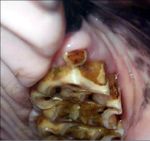Difference between revisions of "Alimentary System - Horse Anatomy"
| Line 38: | Line 38: | ||
==Small Intestine== | ==Small Intestine== | ||
==Large Intestine== | ==Large Intestine== | ||
| + | ===Introduction=== | ||
| + | The horse is a monagastric hindgut fermenter. The horse evolved for grazing and it does so for up to 17 hours a day. A high proportion of the horse's dietary carbohydrate is in the form of '''starch'''. A mature horse eats 2-2.5% of it's body weight in dry matter every day, 1.5-1.75% of this should be fibre (hay/haylage). This is to prevent a rapid drop in pH in the large intestine and also to stimulate peristalsis in the gut and prevent build up of gas. | ||
| + | |||
| + | Undigested material spends a long time in the [[Caecum - Anatomy & Physiology|caecum]] and [[Large Intestine - Anatomy & Physiology|large intestine]] being digested by microbial fermentation, mainly cellulose (95% after 65 hours). | ||
| + | |||
| + | In the hindgut of the horse; 75-85% of insoluble carbohydrates is digested, 15-30% of soluble carbohydrates and 30% of protein digestion. A lot of absorption of [[Volatile Fatty Acids|volatile fatty acids (VFAs)]] and water occurs in the large intestine which pass readily into the blood. Electrolytes are also absorbed in the large intestine; 95% of sodium and chloride and 75% of potassium and phosphate. | ||
| + | To mix the contents of the large intestines, the taenia and circular muscle of the tunica muscularis contract. This also transports the ingesta through the large intestine and brings the products of fermentation in contact with the epithelium. | ||
| + | |||
==Liver== | ==Liver== | ||
==Pancreas== | ==Pancreas== | ||
Revision as of 21:35, 7 November 2012
| This article is still under construction. |
Oral Cavity
Teeth
Dental Formula
The formula for deciduous teeth: 2 (I3/3 C0/0 P3/3)
The formula for permanent teeth: 2 (I3/3 C1/1 P3-4/3 M3/3)
Canines
The canines are rudimentary and in diastema. The size of the root is proportionally larger than the crown.
Molars
The molars have enlarged surfaces and higher crowns. They have delayed root development and complicated folding of enamel.
Incisors
Incisors have high crowns and folded enamel surfaces. Their roots converge.
Premolars
A horse's Wolf tooth (PM1) is often lacking. Molars and Premolars form a continuous surface. Premolars have a high rate of wear and continually erupt. The upper teeth are wider than the lower. There is no infundibulum in the lower teeth.
Ageing
Horses can be aged by their teeth. At 2 and a half the first permanent incisor will erupt; At 3 and a half the second permanent incisor will erupt and at 4 and a half the third permanent incisor will erupt. Over 5 years of age the folding of the enamel ring (infundibulum) can indicate age. There is a 7 year hook and over 13 years of age a dental star will be present.
The Galvayne's Groove is a brown groove on the upper corner incisor teeth and indicates that the horse is over 10 years old. At 15 the groove will be approximately half way down the tooth; At 20 the groove will run down the whole tooth; Over 20 the grove begins to disappear; At 25 the groove will only be visible on the bottom half of the tooth. At 30 the groove will usually be gone.
Palate
Oesophagus
Stomach
Small Intestine
Large Intestine
Introduction
The horse is a monagastric hindgut fermenter. The horse evolved for grazing and it does so for up to 17 hours a day. A high proportion of the horse's dietary carbohydrate is in the form of starch. A mature horse eats 2-2.5% of it's body weight in dry matter every day, 1.5-1.75% of this should be fibre (hay/haylage). This is to prevent a rapid drop in pH in the large intestine and also to stimulate peristalsis in the gut and prevent build up of gas.
Undigested material spends a long time in the caecum and large intestine being digested by microbial fermentation, mainly cellulose (95% after 65 hours).
In the hindgut of the horse; 75-85% of insoluble carbohydrates is digested, 15-30% of soluble carbohydrates and 30% of protein digestion. A lot of absorption of volatile fatty acids (VFAs) and water occurs in the large intestine which pass readily into the blood. Electrolytes are also absorbed in the large intestine; 95% of sodium and chloride and 75% of potassium and phosphate. To mix the contents of the large intestines, the taenia and circular muscle of the tunica muscularis contract. This also transports the ingesta through the large intestine and brings the products of fermentation in contact with the epithelium.

